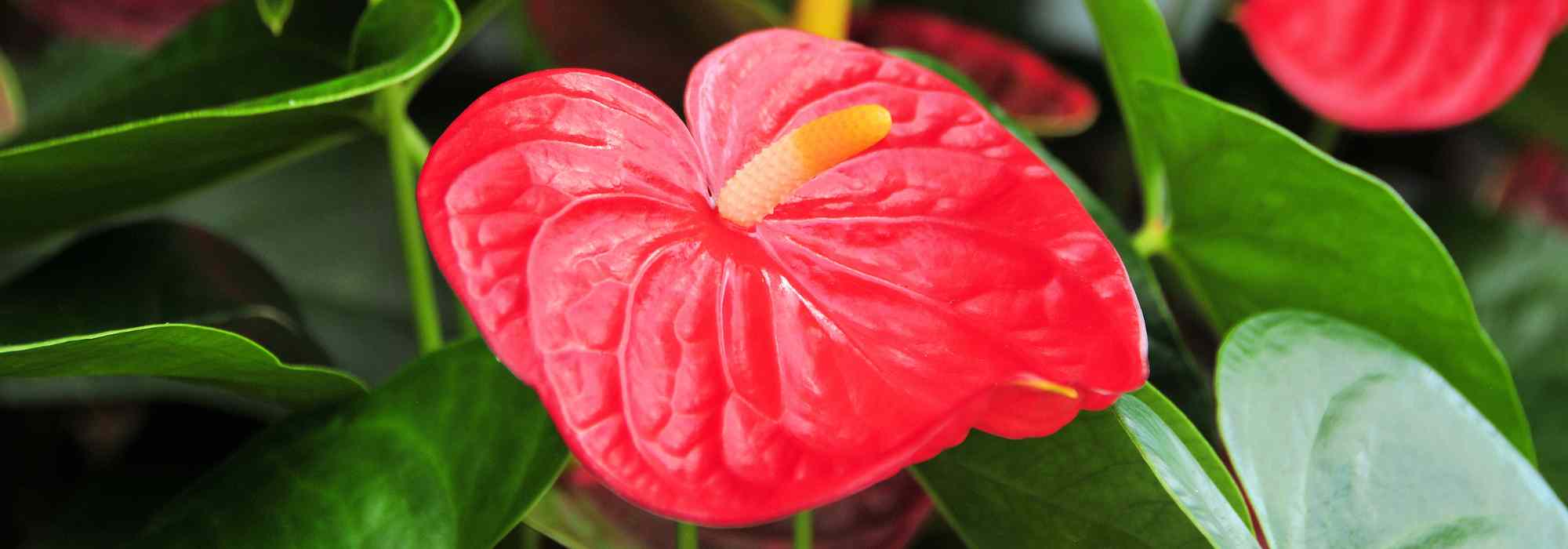
Anthurium - Flamingo flower: how to grow and care for it ?
Contents
The anthurium in a nutshell
- The Anthurium is an elegant tropical plant with bright and colourful flowers, perfect for decorating interiors.
- It prefers bright, indirect light and a light, well-draining substrate.
- Watering should be moderate, with regular misting to maintain good humidity.
- Its long and renewed flowering makes it a highly decorative plant.
- Dividing the clumps is the simplest method to propagate it.
The word from our expert
The Anthurium, a true gem of the tropical forests of Central and South America, captivates with its elegance and spectacular flowering. Belonging to the Araceae family, this houseplant derives its name from the Greek words anthos (flower) and oura (tail), a direct reference to its inflorescence composed of a slender spadix surrounded by a glossy spathe. Nicknamed the flamingo flower or painter’s palette, the Anthurium brightens interiors with its vibrant colours and lustrous foliage, making it a must-have choice for adding a sophisticated and tropical touch to home décor.
Easy to grow, the Anthurium thrives in bright but filtered light, away from direct sunlight. It prefers a light, well-draining substrate, combining potting soil, pine bark, and perlite. Watering should be moderate: it’s best to let the soil dry slightly between waterings to avoid the risk of root rot. Regular misting of its leaves provides the ambient humidity it loves, especially in winter when the air becomes dry.
In terms of care, the Anthurium requires little effort: repotting every 2 to 3 years, light fertilisation in spring and summer, and removing damaged leaves are enough to maintain its beauty. Its flowering, which can last several weeks, renews itself throughout the year if conditions are favourable. For those who wish to propagate it, dividing the clumps in spring is the simplest and most effective method.
Finally, the Anthurium is not just a decorative plant; it is also a true symbol of warmth and hospitality. Whether it stands in a sleek ceramic pot, a wicker planter, or even suspended in a bohemian setting, it adapts to all interior styles. Gifting an Anthurium is offering a touch of timeless exoticism and elegance, an ideal choice to enhance any living space.
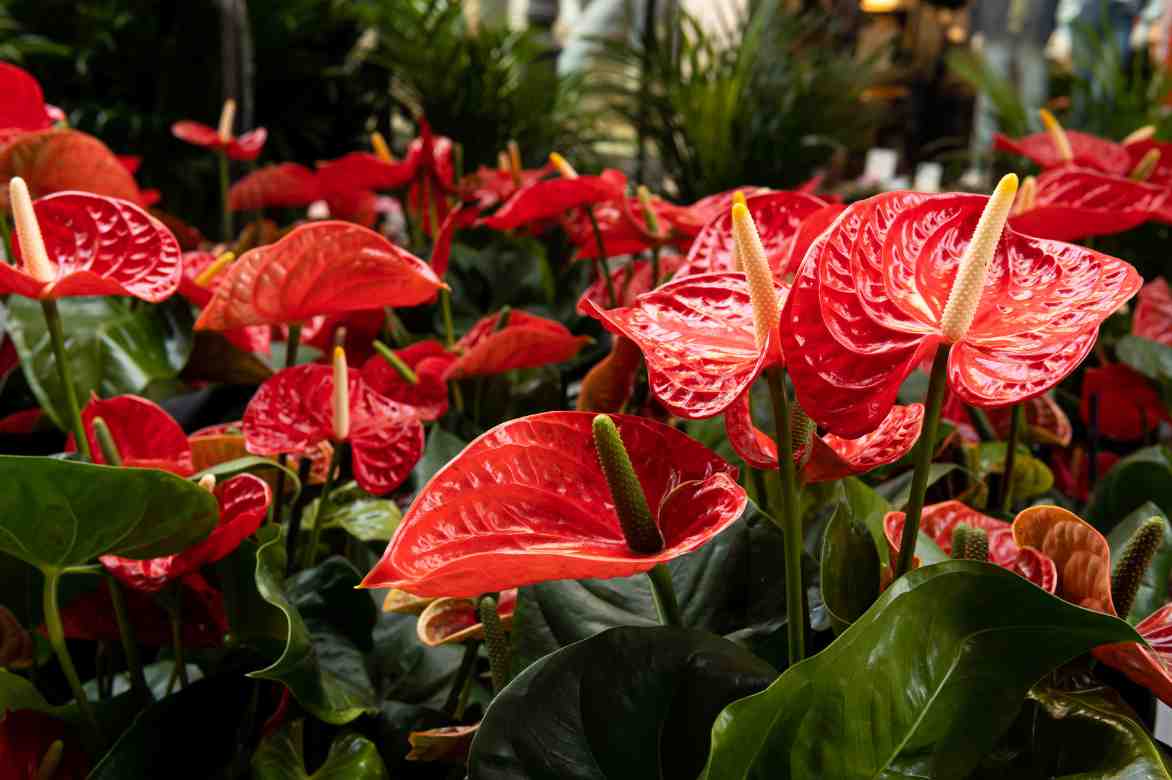
Botany and description
Botanical data
- Latin name Anthurium sp.
- Family Araceae
- Common name Flamingo flower, Tailflower
- Flowering from March to November
- Height 80 cm
- Sun exposure bright, no direct sunlight
- Soil type light and fertile potting mix
- Hardiness 16°C
The Anthurium belongs to the large Araceae family, which includes many tropical plants with decorative foliage and unique flowers. The genus name Anthurium originates from ancient Greek, combining the words anthos, meaning “flower,” and oura, meaning “tail,” a direct reference to the characteristic shape of its inflorescences, where the elongated spadix resembles a tail surrounded by a colourful spathe. In French, this houseplant is often called Flamingo flower or Tailflower, evocative names that reflect the brilliance of its vibrant colours and exotic appearance. It is less commonly referred to in literature by the nickname “anthure.”
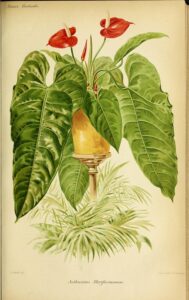
In its natural habitat, the Anthurium thrives in the humid tropical forests of Central and South America, particularly in Colombia and Ecuador. It grows under the shelter of large trees, enjoying filtered light and constant humidity. This adaptation to shady and humid conditions explains why the Anthurium has become such a popular houseplant. Its glossy foliage and spectacular inflorescences bring a touch of exoticism and lasting colour to our interiors, while requiring relatively little maintenance. Its natural elegance and ability to flower year-round make it a must-have for lovers of decorative plants.
Good to know: the Anthurium is recognised for its air-purifying properties, capable of absorbing harmful substances like ammonia, xylene, and formaldehyde present in indoor air.
A vast botanical genus and interesting varieties
Among the many species of Anthurium—over 1,000 in the wild—some stand out for their popularity and ease of cultivation indoors. The Anthurium andraeanum is undoubtedly the most iconic. Native to Colombia and Ecuador, it captivates with its glossy spathe, often bright red, pink, or white, surrounding a yellow or cream spadix. This species has inspired many decorative cultivars.
Another highly appreciated species, the Anthurium scherzerianum is distinguished by its spirally curved spadix, a unique feature that gives it special charm. Its spathes are usually red, but varieties with orange or white hues also exist.
For enthusiasts of more graphic foliage, the Anthurium clarinervium and the Anthurium crystallinum are essential species. They are prized for their large heart-shaped leaves, deep green with striking white veins, offering a spectacular contrast.

On the left, flowering of Anthurium andraeanum and foliage of Anthurium clarinervium. On the right, Anthurium scherzerianum
The numerous cultivars resulting from cross-breeding between species now offer a wide range of colours and forms. Among the most popular are the varieties from the ‘Champion’ series, renowned for their glossy spathes in red, pink, or white hues, or the ‘Dakota’ series, which features darker tones, from deep burgundy to purple. Varieties like ‘Livium’ or ‘Sierra’ offer softer shades, in pastel pink or creamy white.
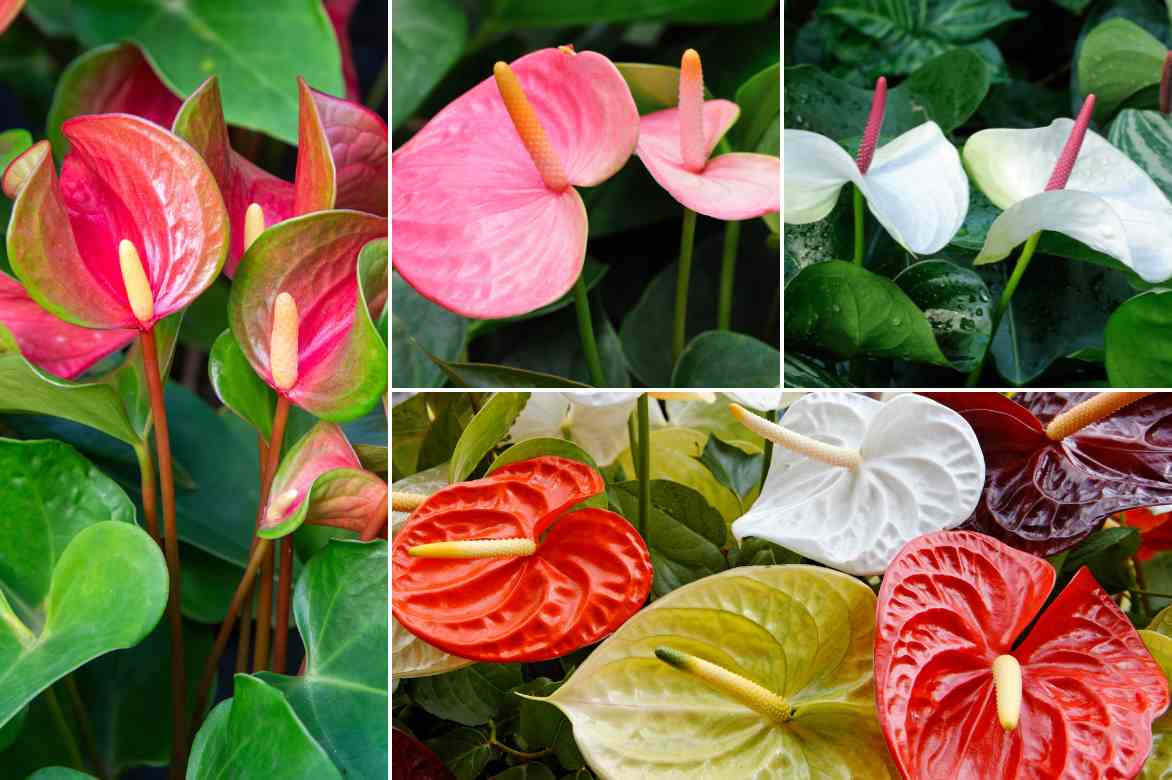
Anthurium flowers come in many colours, from white to purple
Description
The Anthurium has an elegant, often compact habit, though it can spread more airily depending on the species. Its short, sturdy stems bear leaves that rise or spread, giving the plant a dense yet graceful silhouette. Some species develop a more trailing habit, particularly among epiphytic varieties that, in nature, cling to tree branches.
Its root system is both dense and vigorous. It consists of thick, fleshy roots that allow the plant to store water and nutrients, an essential advantage for survival in tropical forests where it often grows epiphytically or semi-epiphytically. Aerial roots also emerge at the base of the plant, seeking ambient humidity and aiding in anchoring and nutrient absorption.
The foliage of the Anthurium is one of its major assets. Its leaves are generally broad, leathery, and glossy, offering varied shapes depending on the species. In Anthurium andraeanum, they are often heart-shaped with a smooth, satiny surface. Species like Anthurium clarinervium or crystallinum reveal thicker, velvety leaves, deep green, enhanced by striking white veins. This evergreen foliage gives the plant a decorative presence even outside the flowering period.
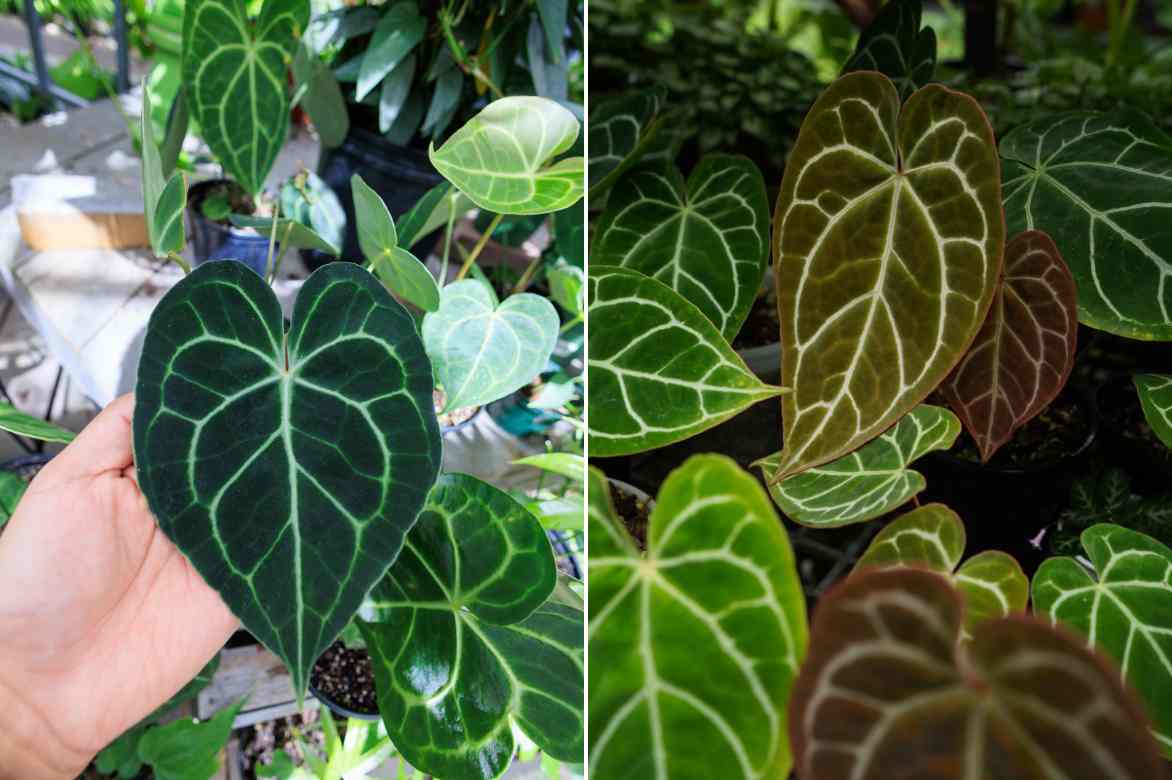
Anthurium crystallinum
The flowering of the Anthurium is as spectacular as it is long-lasting. Its false flower is actually a spathe, a large coloured bract surrounding a spadix, long and cylindrical, where the tiny, inconspicuous true flowers are located. The spathes come in a palette of vibrant colours: red, pink, white, green, purple, and even bicoloured, depending on the cultivar. The flowering can last several weeks, typically between 8 and 12 weeks, and the plant can rebloom several times a year if growing conditions are favourable.
Warning!! The sap of the Anthurium contains calcium oxalate crystals, microscopic particles that can cause skin irritation or reactions in sensitive individuals. When handling the plant, especially during repotting or pruning, it is advisable to wear gloves to avoid contact with the sap.
Cultivation of the Anthurium
Exposure
The Anthurium loves bright, indirect light. Direct light can scorch its leaves, while insufficient light reduces its flowering. Place it near an east or west-facing window, away from direct sunlight.
The optimal temperature for the Anthurium is between 18 and 25°C.
Type of Pot
Use a pot with drainage holes to prevent waterlogging.

Type of Substrate
The Anthurium prefers a light, airy, and well-draining substrate. An ideal mix would be: 1/3 tropical plant compost, 1/3 pine or coconut bark, and 1/3 perlite or sphagnum moss to retain moisture without excess.
Repotting
Repot every 2 to 3 years, preferably in spring. When the roots start emerging from the drainage holes or become crowded, it’s time to move it to a slightly larger pot.
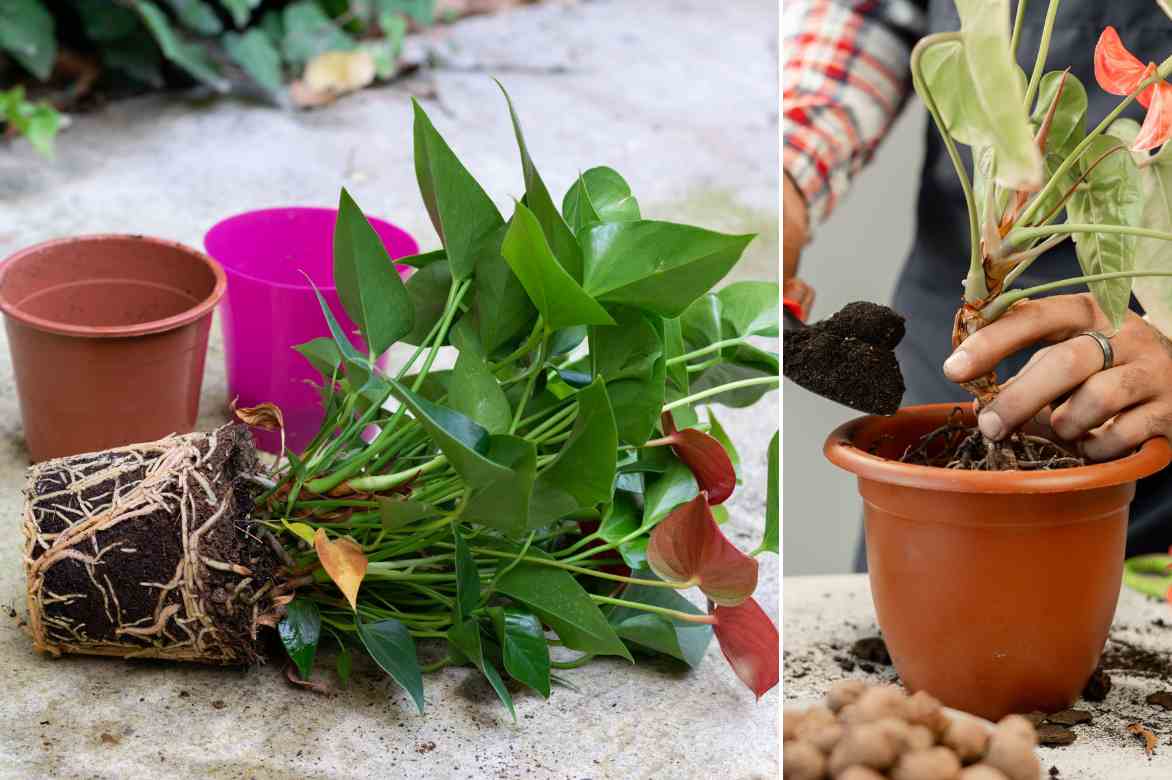
Watering
Water moderately, about once a week in summer and every 10 to 15 days in winter. Allow the top 2-3 cm of the substrate to dry out between waterings. Preferably use room-temperature, low-lime water.
The Anthurium also loves ambient humidity: mist its leaves 2 to 3 times a week, especially in summer, or in winter if the air is dry. Alternatively, place it near a humidifier to help it thrive.
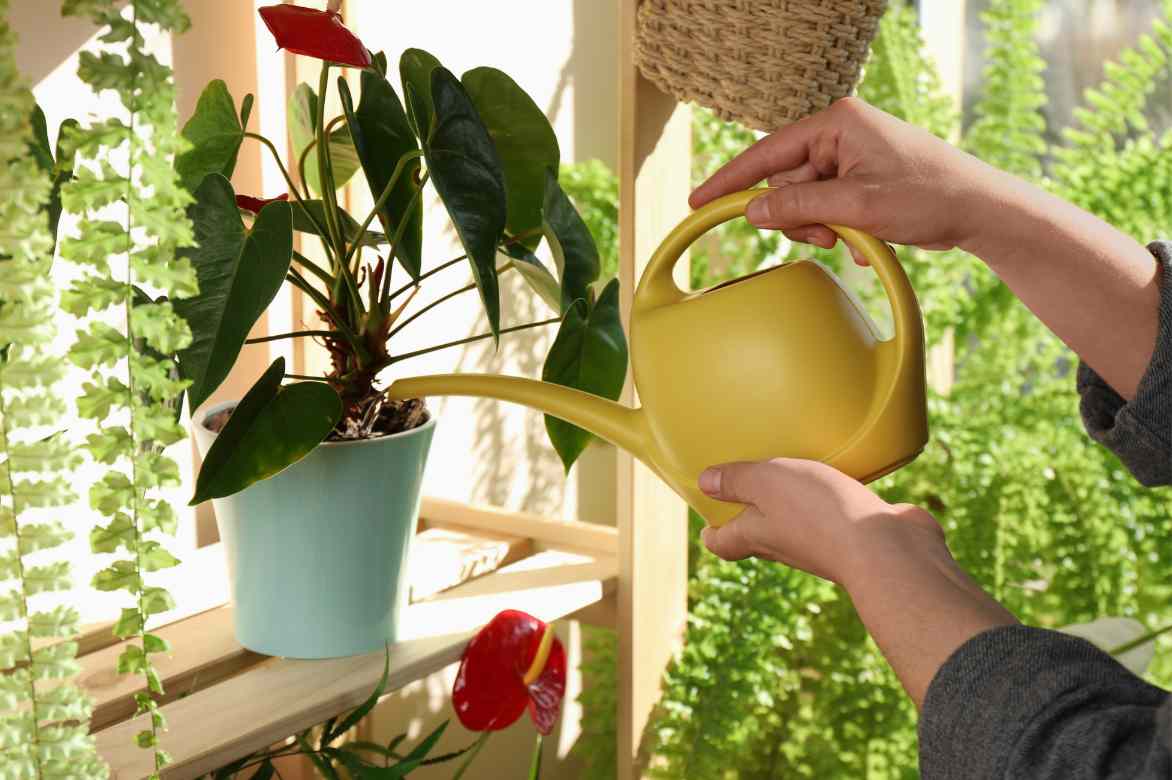
Fertilisation
Apply liquid fertiliser for flowering plants every 4 to 6 weeks in spring and summer. Opt for a phosphorus-rich fertiliser to encourage flowering. In autumn and winter, stop fertilising.
Pruning
Regularly remove yellowed or damaged leaves and spent flowers by cutting them at the base of the stem. This encourages the production of new leaves and flowers.
Possible Diseases and Parasitic Issues in Anthurium
The Anthurium is generally robust, but it can be susceptible to certain diseases and parasitic attacks, especially if the growing conditions are not ideal.
Common Diseases
- Root rot: This is one of the most frequent problems, often caused by overwatering or poorly draining soil. The roots turn black and soft, and the plant shows signs of decline (yellowed, limp leaves). It is important to reduce watering and repot the plant in a more draining substrate.
- Leaf spots (fungal and bacterial): Brown or yellow spots on the leaves may indicate a fungal or bacterial infection. Excessive humidity and poor air circulation encourage these diseases. Remove affected leaves and limit direct misting on the foliage. A fungicidal treatment may be necessary.
- Anthracnose: This fungal disease causes dark spots and necrotic edges on the leaves. It is encouraged by excessive humidity. Remove affected parts and use a suitable fungicide.
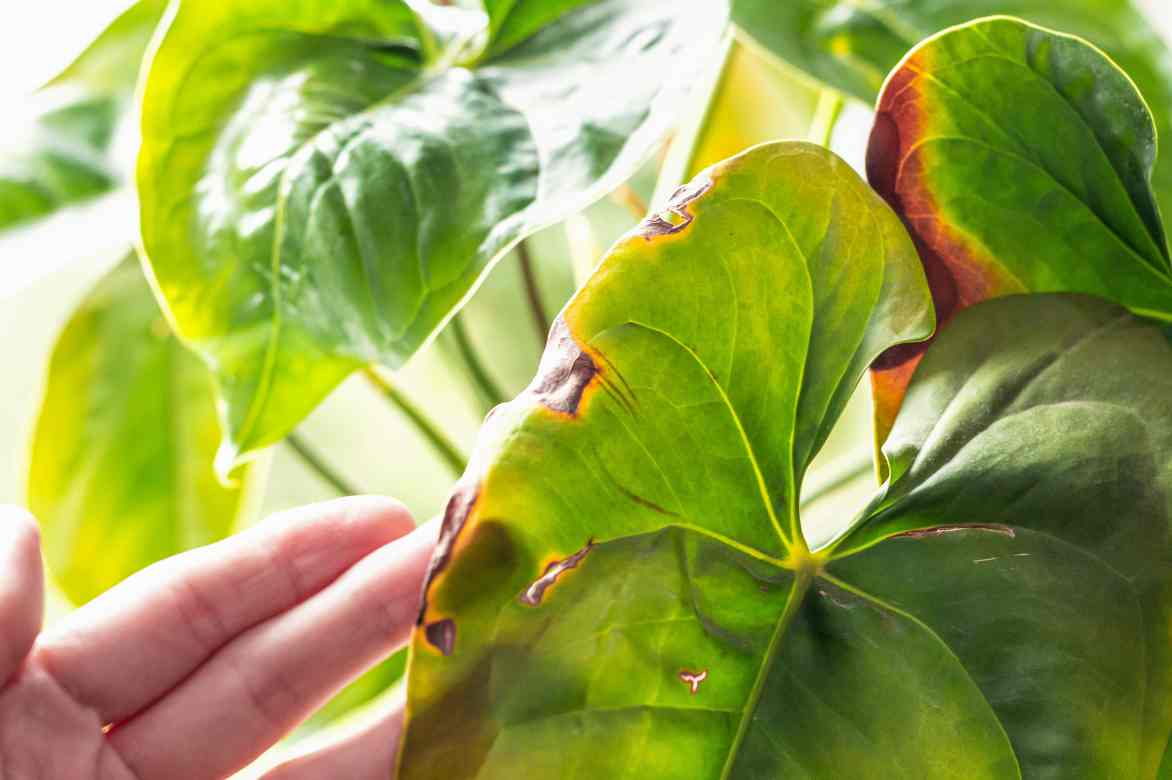
Frequent Parasites
- Mealybugs: They appear as small white cottony masses or small brown shields stuck to the stems and undersides of the leaves. They suck the sap from the plant, leading to general weakening. A treatment with black soap works well to eliminate them.
- Aphids: Less frequent but possible, especially in warm weather. These small green or black insects colonise young shoots. They can be easily treated with soapy water sprays.
- Spider mites: These tiny mites attack the leaves, forming fine webs. They cause discoloured spots and drying of the foliage. They thrive especially in dry air. Increasing ambient humidity and spraying water on the foliage can deter them. In case of infestation, a natural acaricide can be used.
- Thrips: These small elongated insects can deform leaves and leave silvery traces. They can be combated with suitable insecticidal treatments or natural solutions like neem oil.
Prevention
- Maintain a good watering balance—neither too dry nor too wet.
- Promote good air circulation around the plant.
- Regularly clean the leaves with a damp cloth to avoid dust accumulation and deter parasites.
- Quarantine any new plant before adding it to the collection to prevent the spread of parasites.
→ Also read: Anthurium Diseases and Parasites: Identify, Treat, and Prevent.
How to propagate an Anthurium?
Propagating Anthurium is quite straightforward and is mainly done by dividing clumps or by stem cuttings. Here are the detailed steps to succeed in this process:
By dividing clumps (the simplest method)
- Choose the right time: the best period to divide an Anthurium is in spring or early summer, when the plant resumes its growth.
- Remove the plant from its pot: gently take the plant out of its pot while holding the base of the foliage. If the roots are too tight, lightly tap the sides of the pot to ease removal.
- Untangle the roots: carefully remove excess substrate around the roots and separate the different shoots. Anthurium naturally forms several offshoots or small shoots at the base. Simply separate these young plants with care.
- Make clean cuts: if the clumps are too tangled, use clean and disinfected pruning shears to cut the roots, ensuring each division has healthy roots and a few leaves.
- Repot the divisions: plant each division in a suitable pot filled with a light and well-draining substrate (tropical plant compost, pine bark, perlite).
- Water lightly: water moderately to moisten the substrate without soaking the soil. Then place the young plants in a bright spot, but away from direct sunlight.
By stem cuttings (longer but possible)
- Take a stem cutting: cut a healthy stem with at least one node (the area where roots and leaves emerge).
- Plant in moist substrate: place the stem in a light mixture (sphagnum moss alone or a compost/perlite mix). You can also try propagation by cuttings in water, by submerging the base of the stem in a glass of clear water.
- Create a humid environment: cover the cutting with a transparent plastic bag or place it under a mini greenhouse to maintain high humidity, ensuring condensation does not touch the stem.
- Wait for rooting: place the cutting in a bright and warm spot (20-25°C). The first roots usually appear after 3 to 6 weeks.
- Repot: once the roots are well-developed, you can transplant the cutting into a pot with suitable substrate.
How to best showcase an Anthurium?
The Anthurium, with its glossy foliage and vibrant flowers, is an elegant and modern plant that adapts to many interior styles. Its graphic silhouette and bright colours make it a real decorative asset!
In which type of interior does the Anthurium thrive?
- Modern and minimalist interiors: Its clean lines and bold colours (red, pink, white, green) add a touch of vitality without overwhelming the space. It contrasts beautifully with white walls and raw materials like concrete or light wood.
- Tropical or bohemian settings: Placed among other green plants (Monstera, Pilea, Ficus…), the Anthurium enhances an urban jungle atmosphere. Its flowers add colour amidst lush foliage.
- Glamorous or sophisticated décor: With its glossy flowers and shiny leaves, it fits perfectly in chic interiors, pairing with gold accents, marble, or deep tones like midnight blue or emerald green.
- Zen and minimalist spaces: In a subdued setting, the Anthurium becomes a focal point thanks to its elegant shape and colours. Perfect for a relaxing and wellness-oriented ambiance.
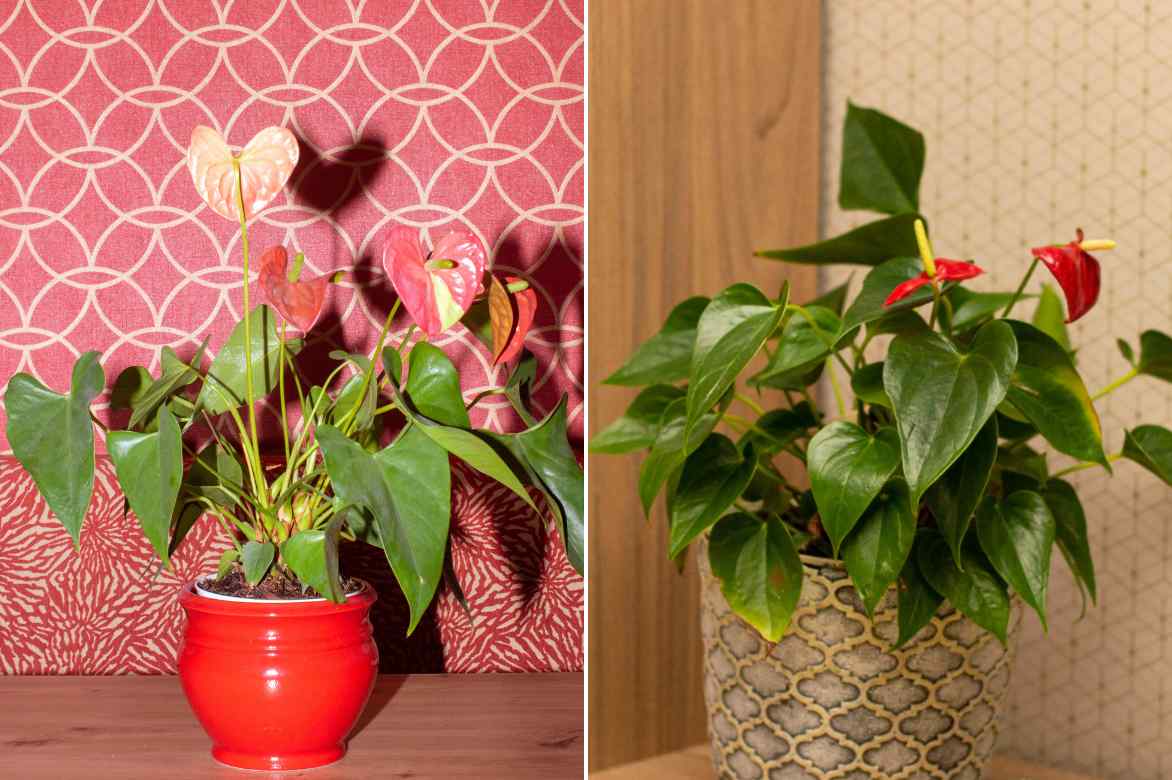
In harmony with its pot and wallpaper, or in understated décor, the Anthurium will find its place everywhere
What style of pot best showcases it?
- Smooth and glossy ceramic pots: A white, black, or pastel pot highlights the Anthurium’s natural elegance and accentuates its vibrant colours. This choice is perfect for a modern and minimalist interior.
- Natural-material planters: Wicker, rattan, or raw terracotta enhance a natural and bohemian vibe. This creates a pleasant contrast with the plant’s shine.
- Metallic pots (gold, copper, brass): Ideal for a chic and refined décor, metal adds a touch of sophistication and brings out the deep green of the foliage.
- Geometric or designer pots: Original shapes or graphic patterns emphasise the plant’s contemporary side, perfect for bolder interiors.
- Hanging or elevated pots: Placing the Anthurium at height, on a stand or in a hanging planter, draws attention to its flowering and adds lightness to the décor.
Decorative tips
- Pair it with mirrors or reflective surfaces to enhance the shine of its leaves.
- Create contrast by placing it against a dark wall (anthracite grey, deep blue) to make its colours pop.
- Combine it with other plants featuring textured foliage to play with contrasting shapes.
Also worth reading
→ Discover our wide range of houseplants.
→ Many books on houseplants exist, but we recommend THE bible on the subject: The Encyclopaedia of Houseplants by Solène Moutardier, published by Ulmer.
- Subscribe!
- Contents
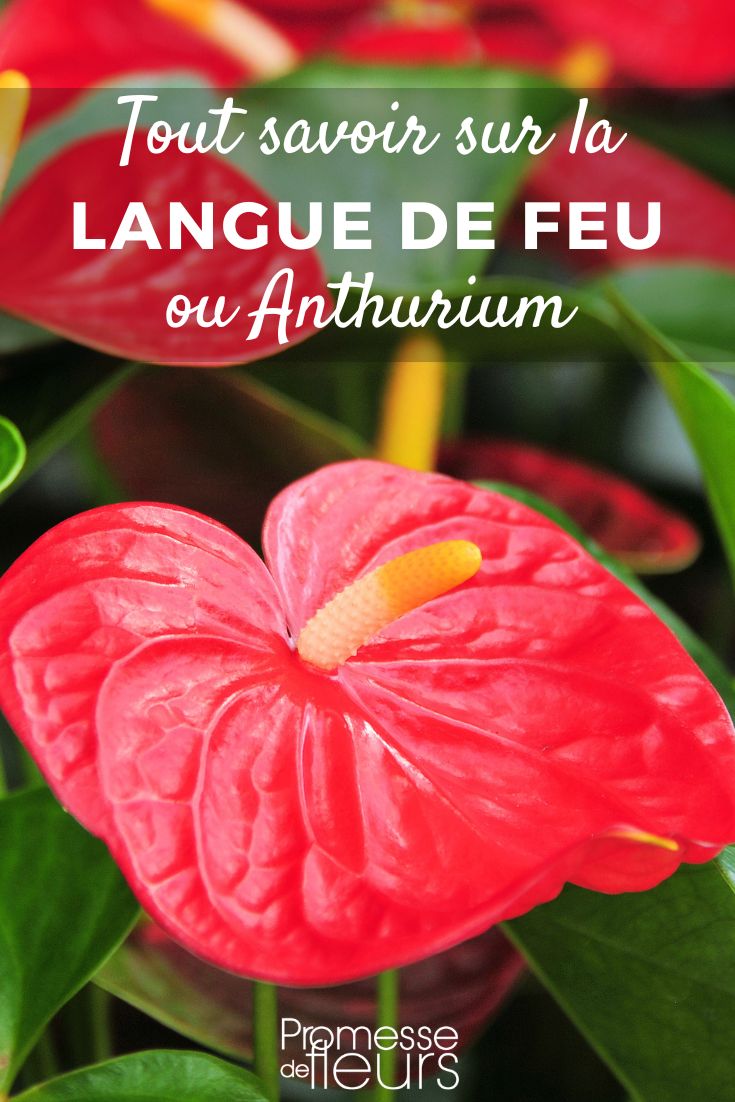































Comments